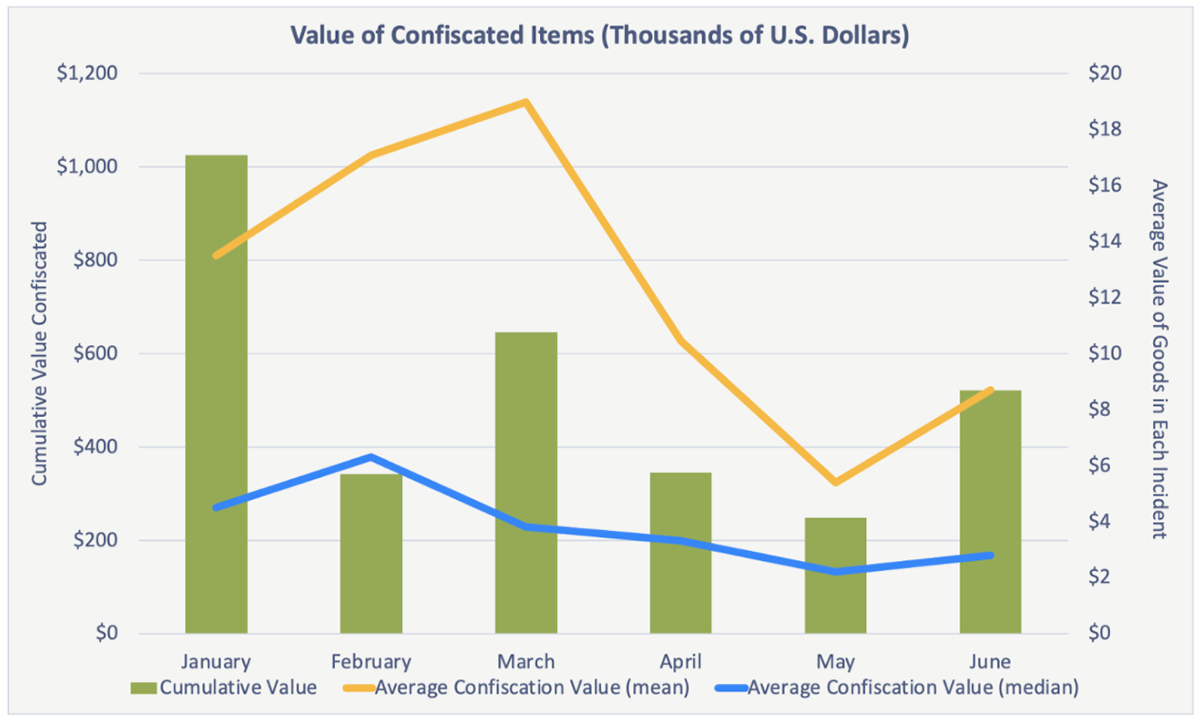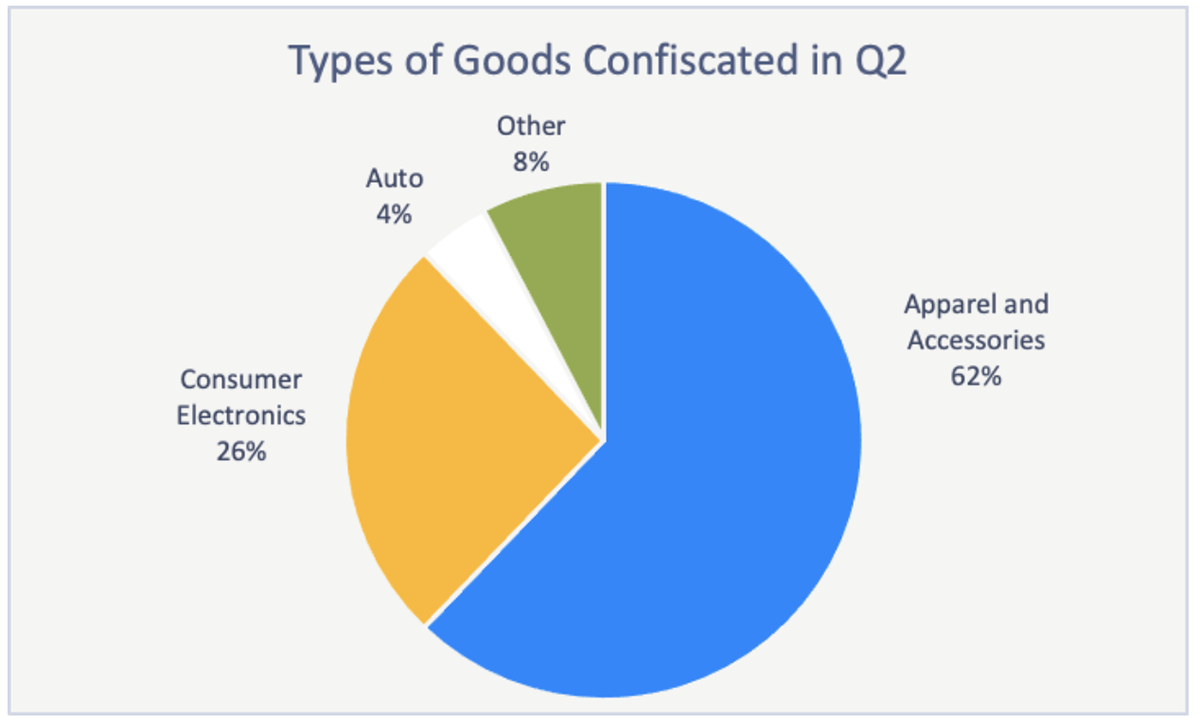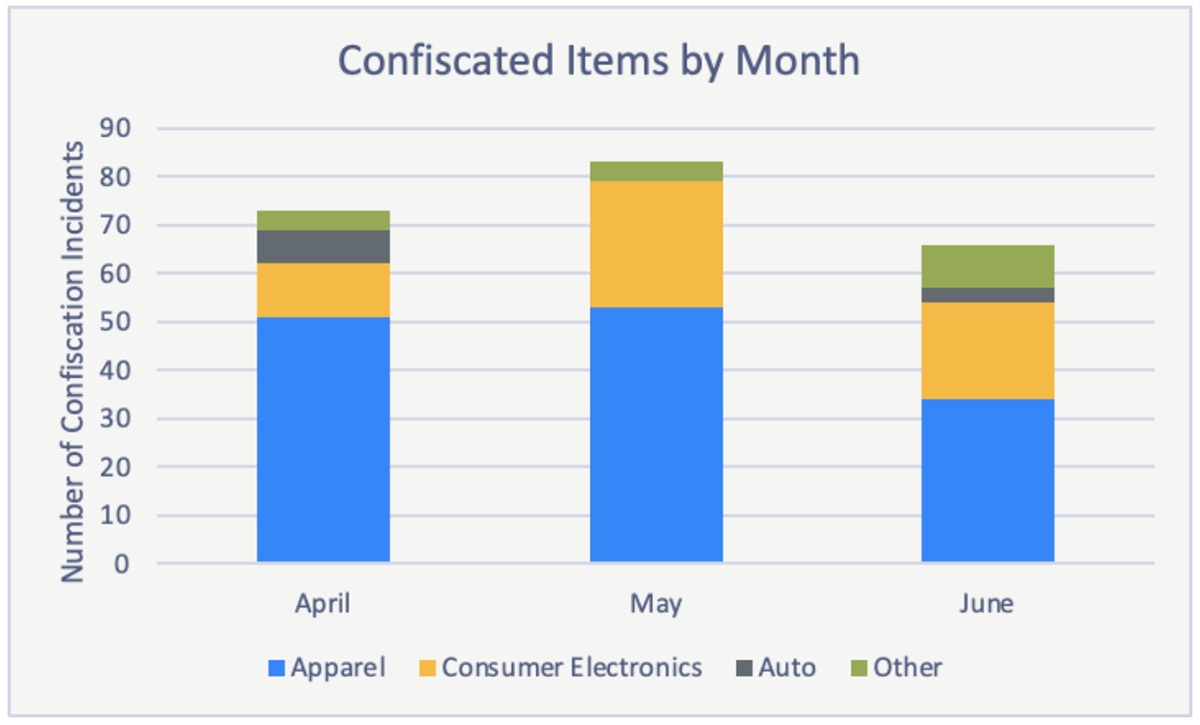This report is part of our quarterly series on counterfeit goods and intellectual property infringement cases reported by the Shenzhen Customs Administration.
As part of an ongoing effort to reduce copyright infringement, the Shenzhen Customs Administration (中华人民共和国深圳海关) regularly publishes information about imitation brand goods confiscated at the border. Each announcement includes information about the brand infringed, the value of the goods confiscated, and identifying information about the company attempting to smuggle said goods.
This report was compiled from all announcements concerning counterfeit goods confiscated by the Shenzhen Customs Administration in the second quarter of 2021.
Authorities reported approximately 140 seizures during the second quarter of this year, about the same number of incidents as recorded during the first quarter. However, the average value of goods in each incident was half that observed during the first quarter. The types of goods being fabricated remained the same throughout the first half of this year, and mostly consisted of apparel and accessories, or consumer electronics.
Why Shenzhen?
Shenzhen is a key location in the international counterfeit goods trade due to its role as the People’s Republic of China’s primary access point to Hong Kong.
According to a study by the Organization for Economic Co-operation and Development (OECD), Hong Kong is the single largest transfer point in counterfeit goods distribution worldwide. The same study found that 55 percent of global counterfeit goods originated from the People’s Republic of China, and 28 percent originated from Hong Kong.
Shenzhen is home to the world’s fourth largest container port, and a major manufacturing center for both domestic and international brands. The city directly borders Hong Kong, which is both an internationally connected commercial city and the world’s eight largest container port.
Shenzhen’s proximity to Hong Kong allows individuals and businesses easy access to both ports, making it the gateway between Hong Kong and the People’s Republic of China.

Image of the Shenzhen-Hong Kong border at Lo Wu. Right: Luohu District, Shenzhen Left: New Territories, Hong Kong.
Smuggling frequency remains constant, while value drops
In the second quarter of 2021, we counted 142 announcements from the Shenzhen Customs Administration of discovered counterfeit goods, with a cumulative value of $1 million (7.2 million RMB). The frequency is approximately the same as what was observed last quarter (135 incidents), though the value associated is half of what was observed previously.
It is possible this change is due to seasonal trends. As we continue to collect data, we will be able to form a baseline from which to compare changes on an annual basis.

Figure 1. The cumulative and average value of confiscated goods fell by approximately half during the second quarter of 2021, despite the number of incidents remaining nearly constant.
In each confiscation announcement, the Shenzhen Customs Administration includes a list of brands that were infringed on. We tracked each brand and the goods associated with them to compile a list of types of goods seized by authorities. A single seizure may contain imitations of multiple brands, which we counted as multiple instances of copyright infringement.
Though the value of smuggled goods dropped, the types of goods mimicked those observed in Q1. Apparel, consumer electronics, and automotive brands make up the bulk of the counterfeit goods seized. Like last quarter, apparel made up over 60 percent of copyright infringement incidents and consumer electronics made up over 25 percent. Automotive goods accounted for less than 5 percent of the incidents observed. The handful of brands that didn’t fit into these categories include high end sporting equipment and e-cigarettes, however these cumulatively represented only 8 percent of copyright infringement incidents during Q2.

Figure 2. Cumulative confiscations by Shenzhen authorities in Q2 by product type.

Figure 3. Types of goods confiscated by month. Each incident represents one copyright infringement charge. Entities caught smuggling goods infringing on multiple brand copyrights were counted as multiple incidents.
Going forward
In addition, we will continue compiling identifying information listed by Shenzhen authorities on companies caught trafficking facsimile branded products.
For detailed information about the brands infringed on, as well as the companies Shenzhen authorities identified as participating in copyright infringement, please download our accompanying dataset.
Shenzhen Customs Seizure Dataset
Request our accompanying dataset for detailed information about the brands infringed on, as well as the companies Shenzhen authorities identified as participating in copyright infringement.
The data for this study was compiled entirely from announcements published by the Shenzhen Customs Administration. The office announces the identities of companies attempting to export goods that violate PRC laws, alongside information about the export goods in question. These announcements are labeled under several kinds of illegal goods, with intellectual property and copyright infringement products falling under their own label.